Mangrove and other blue carbon ecosystems provide extensive climate mitigation and adaptation benefits, as well as a range of other services that underpin coastal livelihoods. Yet these precious ecosystems are being lost rapidly, with devastating consequences for the climate and coastal communities.
Carbon projects have the potential to raise funds to deliver mangrove conservation and restoration through climate finance linked to verified, quantifiable emission reductions. But in coastal contexts, they face a range of technical, financial and policy barriers. These need urgently addressing if blue carbon projects are to fulfil their potential in averting the climate crisis.
Blue Ventures started working on mangroves and blue carbon in 2011 in Madagascar, supporting local communities to develop incentive-based approaches to mangrove conservation and restoration. As well as overcoming various technical and financial challenges, this experience has also helped identify a range of policy barriers. In the context of COP26, Blue Ventures is publishing this report to assist policy makers in ensuring blue carbon reaches its full potential for people and nature.
Four key policy barriers are explored:
- Unclear and insecure tenure;
- Inequitable benefit sharing;
- Misalignment between small-scale blue carbon projects and national REDD+ frameworks; and
- Complexities for blue carbon in the Paris Agreement and countries’ Nationally Determined Contributions (NDCs).



